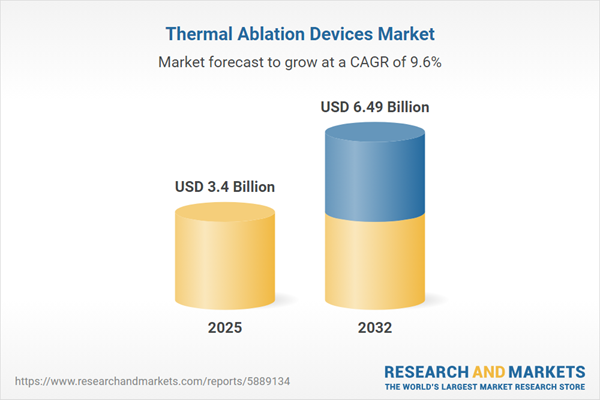Speak directly to the analyst to clarify any post sales queries you may have.
The global thermal ablation devices market is undergoing significant transformation as healthcare leaders seek innovative, minimally invasive treatment solutions to achieve improved clinical outcomes and operational agility.
Market Snapshot: Global Thermal Ablation Devices Market Size and Growth Drivers
The global thermal ablation devices market is projected to expand from USD 3.11 billion in 2024 to USD 3.40 billion in 2025, ultimately reaching USD 6.49 billion by 2032, reflecting a compound annual growth rate (CAGR) of 9.63%. Momentum is driven by accelerated adoption in hospitals, clinics, and ambulatory surgical centers, where organizations are targeting streamlined workflows and consistent patient care improvements. Evolving digital health infrastructure supports integrated, data-driven processes that facilitate diagnostic accuracy and procedural efficiency. Investments are increasingly allocated to digital solutions enabling cross-functional integration, supporting a robust foundation for improved technology adoption in medical environments worldwide.
Scope & Segmentation of the Thermal Ablation Devices Market
- End Users: Ambulatory surgical centers, clinics, hospitals, and research institutes deploy thermal ablation devices to accelerate procedure completion, address diverse clinical priorities, stimulate research, and remain responsive to shifting healthcare demands.
- Applications: Used in cardiology to manage arrhythmias, in oncology for precise tumor ablation, by gynecologists for uterine fibroids, and in dermatology clinics for lesion and tattoo removal. These diverse uses reflect the wide applicability of the technology across a range of medical specialties, granting senior leaders numerous avenues to optimize care delivery and expand service portfolios.
- Delivery Modes: Laparoscopic, percutaneous, and open surgical options are available, offering clinicians the flexibility to match intervention modalities to unique patient and procedural requirements, supporting customized care pathways.
- Technologies: This segment features cryoablation (utilizing argon or nitrous oxide), high-intensity focused ultrasound enhanced by integrated imaging, several laser technologies including CO2, diode, and Nd YAG, as well as microwave and radiofrequency ablation systems. These technical options enable organizations to select solutions tailored to clinical environment constraints and patient demographics.
- Geographic Coverage: Key regions include the Americas, Europe, Middle East and Africa, and Asia-Pacific. Each region’s adoption patterns, regulatory approach, and underlying health infrastructure shape both opportunities and barriers, influencing strategies related to investment, market entry, and technology deployment.
- Key Companies: Medtronic plc, Boston Scientific Corporation, Johnson & Johnson, Siemens Healthineers AG, GE HealthCare Technologies, Koninklijke Philips N.V., Abbott Laboratories, AngioDynamics, Neuwave Medical, and Hologic are among the leading players driving technology advancement, expanding through partnerships, and improving access via ongoing innovation.
Key Takeaways for Senior Decision-Makers
- Integrating thermal ablation devices into care protocols enhances clinical workflow, fosters efficient recovery, and supports consistent outcomes, strengthening institutional competitiveness.
- Artificial intelligence and advanced analytics are being integrated, optimizing image-guided accuracy and facilitating procedural standardization while enabling scalable improvements across networks.
- Modern device connectivity and real-time data sharing facilitate harmonized care protocols and boost multi-site collaboration, ensuring rapid dissemination of best practices and clinical insights.
- Strategic collaborations with digital health companies and academic players encourage product innovation, helping organizations rapidly adapt to changing market and regulatory demands while navigating evolving reimbursement landscapes.
- The rise of hybrid platforms and real-time feedback systems expands the spectrum of available therapies, allowing healthcare providers to deliver advanced options to a broader range of patient scenarios and treatment settings.
- Flexible business models give organizations the agility to respond to shifting regulations and reimbursement structures, laying the foundation for greater resilience and sustained operational growth.
Tariff Impact: Navigating United States 2025 Import Measures
Forthcoming U.S. import tariffs are impacting the cost structure for thermal ablation device components, prompting providers to focus on strengthening domestic manufacturing capabilities and diversifying supplier networks. Building resilient supply chains, updating procurement strategies, and maintaining proactive stakeholder communications are essential for healthcare organizations to avoid operational disruptions and maintain compliance amid these policy shifts.
Methodology & Data Sources
The report findings are supported by comprehensive secondary research and include perspectives gathered from senior healthcare technology leaders. Customized quantitative models, anchored to industry standards, inform robust market forecasts and deliver insights applicable to executive decision-making.
Why This Report Matters
- Enables precise market benchmarking and segmentation, providing a foundational resource for strategic planning in competitive B2B sectors.
- Delivers reliable updates on regulatory trends and emerging technologies, equipping executives to anticipate industry changes and manage product portfolios across their lifecycle.
- Identifies operational vulnerabilities and proposes strategies for enhancing supply chain resilience, supporting informed responses to market and tariff-related disruptions.
Conclusion
Thermal ablation devices, when combined with adaptive strategies and integrated technologies, empower healthcare organizations to achieve improved patient outcomes and sustain operational agility in an evolving global market.
Additional Product Information:
- Purchase of this report includes 1 year online access with quarterly updates.
- This report can be updated on request. Please contact our Customer Experience team using the Ask a Question widget on our website.
Table of Contents
3. Executive Summary
4. Market Overview
7. Cumulative Impact of Artificial Intelligence 2025
Companies Mentioned
The companies profiled in this Thermal Ablation Devices market report include:- Medtronic plc
- Boston Scientific Corporation
- Johnson & Johnson
- Siemens Healthineers AG
- GE HealthCare Technologies, Inc.
- Koninklijke Philips N.V.
- Abbott Laboratories
- AngioDynamics, Inc.
- Neuwave Medical, Inc.
- Hologic, Inc.
Table Information
| Report Attribute | Details |
|---|---|
| No. of Pages | 182 |
| Published | October 2025 |
| Forecast Period | 2025 - 2032 |
| Estimated Market Value ( USD | $ 3.4 Billion |
| Forecasted Market Value ( USD | $ 6.49 Billion |
| Compound Annual Growth Rate | 9.6% |
| Regions Covered | Global |
| No. of Companies Mentioned | 11 |









